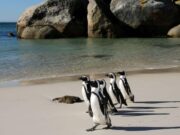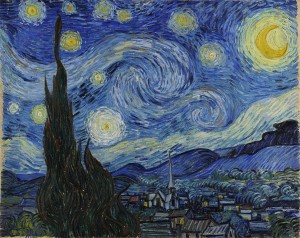Van Gogh clouds! Like breaking ocean waves.
They are called Kelvin Helmholzt clouds, aka billow clouds or shear-gravity clouds
It’s widely believed that these waves in the sky inspired the swirls in Van Gogh’s masterpiece Starry Night.
Here’s a special kind of cloud known to scientists as a Kelvin Helmholtz cloud. These clouds look like breaking ocean waves, with the rolling eddies seen at the top of the cloud layers usually evenly spaced and easily identifiable.
Kelvin Helmholtz clouds are named for Lord Kelvin and Hermann von Helmholtz, who studied the physics of the instability that leads to this type of cloud formation.
A Kelvin Helmholtz instability forms where there’s a velocity difference across the interface between two fluids: for example, wind blowing over water. It is also called billow clouds that form when two different layers of air in our atmosphere are moving at different speeds
 You’ll often see the characteristic wave structure in this type of cloud when two different layers of air in our atmosphere are moving at different speeds. The upper layers of air are moving at higher speeds and will often scoop the top of the cloud layer into these wave-like rolling structures.
You’ll often see the characteristic wave structure in this type of cloud when two different layers of air in our atmosphere are moving at different speeds. The upper layers of air are moving at higher speeds and will often scoop the top of the cloud layer into these wave-like rolling structures.
The clouds often form on windy days, when there’s a difference in densities of the air, for example, during a temperature inversion. They’re often good indicators of atmospheric instability and the presence of turbulence for aircraft.
“Billow clouds,” are produced by instability, when horizontal layers of air brush by one another at different velocities

Source: EarthSky










